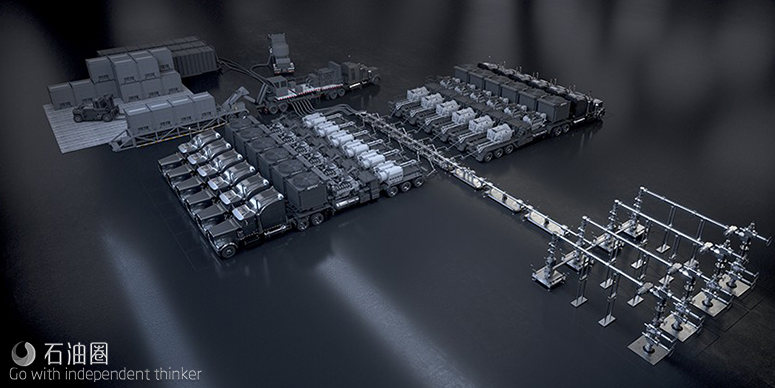Weir Oil & Gas, a provider of pressure pumping and pressure control equipment and services, announced its latest innovations – the Simplified Frac Iron System and the Pressure Control Intelligent System – at the 2017 OTC in Houston. Both technologies were created in response to operator demand for technologies that allow them to be competitive in a lower oil price environment, according to Weir. “We were hearing we’ve got to reduce nonproductive time, we’ve got to create greater operational efficiencies and increase the reliability of equipment, and we need more data,” Paul Coppinger, President of Weir Oil & Gas, said at OTC.
Most frac operations today consist of multiple well pads and hundreds of moving parts, including small-bore iron strings to manage very high pressures. All of these pieces of iron and equipment require a lengthy time to set up, assemble and connect, with every connection posing a potential leak path that must be checked continuously. This task creates substantial nonproductive time on site.
The Simplified Frac Iron System was designed to make the frac process simpler, safer and more productive. “It dramatically reduces the amount of iron that’s on a frac location. There are fewer connections, less nonproductive time, enhanced safety and increased reliability,” Mr Coppinger said.
The streamlined, fit-for-purpose system can be tailored to any condition or basin. This linear-flow-path design also prevents directional fluid changes that create accelerated wear, resulting in longer product life and reduced pressure drops in demanding conditions. Additionally, a rotating flange and adjustable height spool is located on the frac stack to enable better alignment.
In testing, Weir’s One-Straight Line (OSL), a component of the simplified frac iron system, completed 80 frac stages with minimal pipe wear during a field trial in Canada. The system lasted more than three times longer than similar applications and demonstrated approximately 70% less pipe erosion compared with similar designs.
Another challenge Weir has recently responded to is the ability for operators to pinpoint actual, real-time fluid levels and gas flow rates in pressure control equipment. The methods they relied on to obtain this information are prone to human error. As a result, they can be unaware of a problem until a tank overflows or a kick occurs, when they have only minutes to respond.
Engineered for high-pressure formations, Weir’s line of Pressure Control Intelligent Systems uses an Internet of Things (IoT) approach that is safer, faster, more accurate and more reliable. “We’re able to give them a greater and greater level of precision,” Matt Green, Engineering Manager for Technology Innovation, said. “We’re tying it to the data portal and where the customers are able to access that information, both for reporting and analysis.”
Each of the systems’ components connects to a control unit via sensors that send real-time information from the equipment back to the control unit. The data is relayed to the operator in a secure, cloud-based portal, accessible by desktop and mobile devices and stored in Weir’s electronic data warehouse for historical reference. Should an issue with levels arise, the system will sound the alarm much sooner to ensure the operator has more time to adjust the flow from the choke or for the choke to adjust automatically.
The system is also modular, giving operators the choice to fully integrate the systems or collect, monitor, analyze and notate the data separately for Weir’s Mathena Mud Gas Separator Intelligent System, Mathena Vent Gas Analyzer and Intelligent Flow Meter System, Mathena ECO-Tank Intelligent System, and Mathena Frac Flowback Intelligent System.
Currently, Weir is operating multiple Pressure Control Intelligent Systems in the field. The Mathena Mud Gas Separator Intelligent System is mitigating issues in the Bakken, where fluid overflow into the gas vent line is common. Along with reducing HSE risks, it has alleviated approximately 12 overflow incidents per month and saved thousands of dollars in clean up costs and nonproductive time, according to the company.
Less iron on the frac site.
With our new Simplified Frac Iron System, Weir Oil & Gas has dramatically reduced the amount of iron on the frac site, replacing multiple iron strings, numerous turns and connections found in traditional configurations with a safer, straighter, more streamlined large-bore design.
Reduced non-productive time and costs
Customized to any basin or condition, this system is designed to improve safety and performance, minimize pressure-drop and erosion—thus extending equipment life—and reduce non-productive time, rig-up time, and material and labor costs.
Fewer leak paths, greater reliability
Throughout Weir Oil & Gas’ Simplified Frac Iron System, we’ve replaced the numerous hammer-union connections with safer API-6A flange connections. These standardized connections, which rarely require tightening in the field, feature reliable metal-seal gaskets—and since there are fewer of them, we have dramatically reduced the number of potential leak paths.
A streamlined, modular large-bore iron
Pre-assembled on modular skids with single large-bore connections in-between the SPM® Simplified Frac Iron allows for easier, faster, and safer setup of the frac-site and can accommodate a wide variety of site configurations.
Faster rig-up
Weir Frac Iron SystemThe linear, large-bore design of the system’s pressure control components, several of which have patents pending, vastly simplifies and shortens the rig-up process. Single inlets and outlets replace multiple tie-in lines. Adjustable spools and rotating flanges allow for quick alignment between the zipper manifold, the frac tree, and the trunk line.
Field-tested, field-proven
In a recent field test, the pressure-control components of Weir’s Simplified Frac Iron System lasted more than three times longer than a competitor’s previous configuration, which also featured a single-line zipper tie-in.
The number of pipe connections was reduced from 100 to 12, eliminating the potential for leak paths by 88 percent (rig site set-up will vary total reduction). An internal CFD analysis of the Weir configuration predicted approximately 70 percent less pipe erosion compared to similar designs

 石油圈
石油圈
